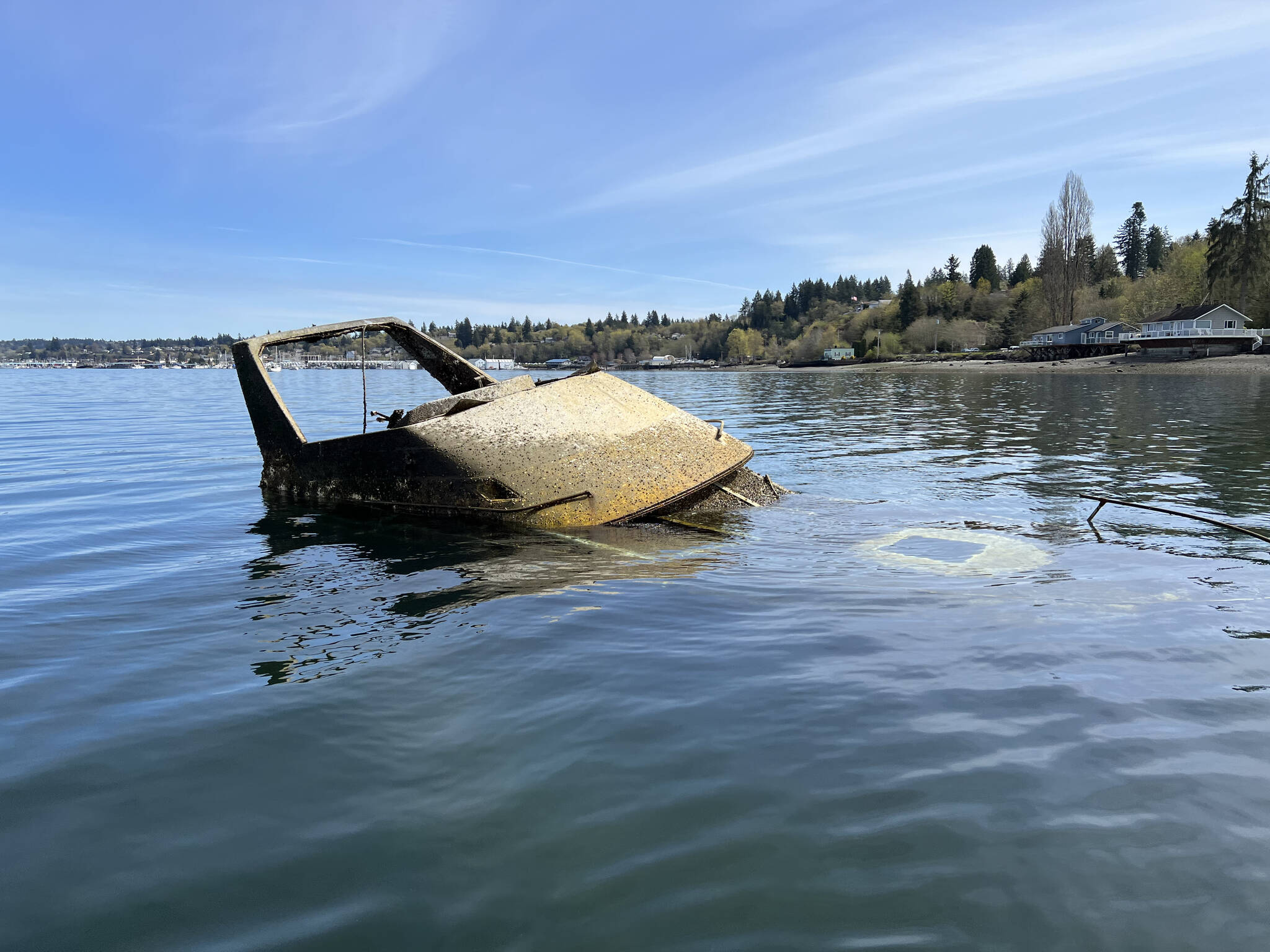We hear a lot about climate change, but few have the opportunity to see the changes up close.
From the helm of his 15-foot twin-hull boat, Dale “Doc” Thoke has kept his eyes on the water-conducting research all over Puget Sound for 38 years. But his videos of the seafloor recorded last month in the Sinclair Inlet have him worried about the spread of harmful algae and the health of eelgrass beds around Bainbridge Island.
Through his company, TMKey Film/Research (TFR) a Washington state master contractor for environmental services, Thoke maps shoreline changes, conducts underwater research and identifies invasive species and early detection of water contaminants.
Thoke scours the shoreline and seafloor looking for derelict gillnets, also known as “ghost nets,” which kill thousands of fish and birds. He also locates sunken boats and debris as he keeps watch on marine and plant life that live beneath our Northwest waters.
Thoke started taking pictures in 1985 while running salmon fishing charters, which then led to his environmental work to identify concerns mandated by state and national environmental agencies.
TFR has partnered with federal, state and tribal authorities on 30 research and cleanup projects around the region, including Orca whale research that tested deep-water quality, water temperature, oxygen levels and the wild Chinook salmon migration path into South Puget Sound spawning estuaries.
For years TFR has developed a network with private property beach owners, educational and environmental groups to share information and locations of sound-wide shore problems, and has removed ghost nets with Quinault, Nisqually, Puyallup and Suquamish tribal fishers.
In June, TFR will bring underwater diver drones to conduct a 50-day study of the eelgrass beds around Bainbridge Island. Volunteers are needed to document and record conditions on the seafloor.
“A picture says a thousand words, and seeing is believing when pollutants are floating in front of your eyes,” said Thoke, who also records the location, seafloor temperatures, water quality readings and uses specialized filters to spot septic polluted areas during his outings.
The state’s native eelgrass meadows are vital in providing habitat for many organisms, including nursery habitat for juvenile salmon, feeder fish and refuge for shellfish from the effects of ocean acidification. Eelgrass also helps prevent erosion and maintains shoreline stability.
But kelp and eelgrass are on the decline. On March 30, Gov. Jay Inslee signed the Kelp Forest and Eelgrass Meadow Conservation Initiative into law to conserve and restore the species of plants that are foundational to the state’s marine ecosystems.
A 2018 study conducted by the Samish Indian Nation on the bull kelp beds in the San Juan Islands found a 305-acre loss of kelp beds from 2006-16, representing a 36 percent decline in one decade. In San Juan County, the Westcott Bay eelgrass meadow covered 37 acres in 2000, but 20 years later less than an acre remains.
The new law goes into effect June 9 and aims to conserve or restore 10,000 acres of these forests and meadows by 2040.
“The biggest part of our eelgrass problem is humanoids,” Thoke said, explaining how boating impacts eelgrass. “For example, boaters tear up the eelgrass beds when they anchor to watch fireworks on the Fourth of July. The day before it looks just like a perfect lawn. Then, the day after, you go there and all the eelgrass is destroyed.” Buoyed and moored boats also destroy eelgrass year-round by blocking light to marine plants.
“It’s going to be interesting to find out about the eelgrass around the island,” Thoke said.
TFR’s custom-made diver drones with specialty filters can search as far as 1,000 feet to capture video and photos of life in the deep.
In March, Thoke found six sunken vessels, two gillnets posing salmon blocking barrier problems and two abandoned outboard motors sinking almost undetectably into the mud of the Gorst Horseshoe. Often, the derelict boats are stolen by individuals who use them for housing and then sink the vessels before moving on.
Thoke said the most pressing concerns facing Kitsap County marine areas are coming faster than originally thought. The bluegreen, red and black algae are now forming in freshwaters, which the Kitsap County Department of Health monitors from spring to fall. Bluegreen algae is a cyanobacterium that produces harmful algal blooms (HABs) that are increasingly contaminating source waters.
“The algae problem in our fresh drinking water is really a concern for me. If an animal drinks water out of a lake with bluegreen algae, the algae will kill it,” Thoke said.
Based on his observations of algae in Puget Sound rivers and lakes, Thoke believes the algae problems stem from the rapid growth of residential properties in Kitsap County and the use of chemicals on lawns and green spaces around family homes and apartment buildings, as well as sewage spills.
“I only know what I see,” Thoke said.
While flying the diver drone in the Gorst waterway last month, research video documented large areas of red algae and dusty plumes of methane gas bubbles escaping from gaping 3-foot-wide holes in the tidal flats near the Port Orchard Boat Ramp.
Thoke wants the public to see those findings. The videos allow people to see environmental changes that have taken place and motivate Thoke to alert and educate the public about these hidden problems. “The key to this is the younger generation. Educating them and getting them involved, letting them know that this is where their earth is right now. This is what’s happening.”
Volunteers sought
Research assistants play an important part in TFR’s effort.
Volunteers often help collect samples, locate debris, identify marine life, record data, take photos and can even “fly” the diver drone to record the conditions around Bainbridge Island shores.
To join the TFR eelgrass research crew this summer, contact Thoke at thokefilm@yahoo.com, or call 253-857-7402. View videos on TFR’s YouTube channel, Doc sees under Puget Sound.



